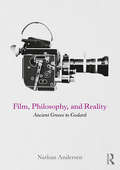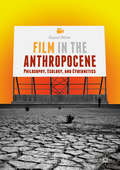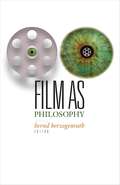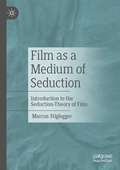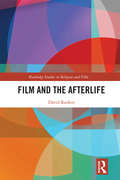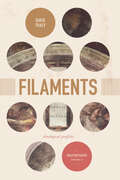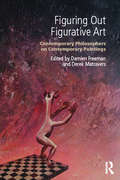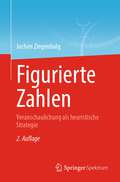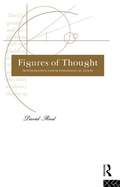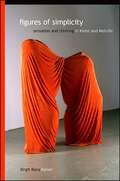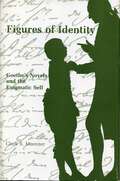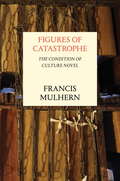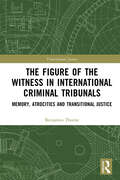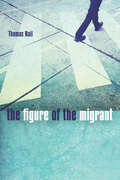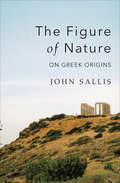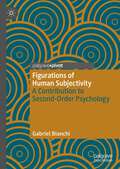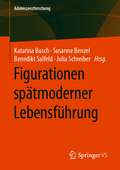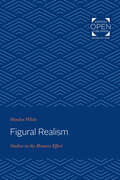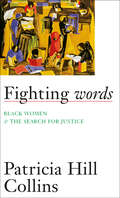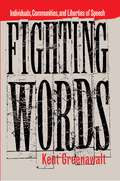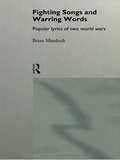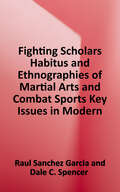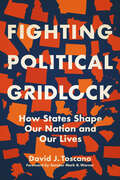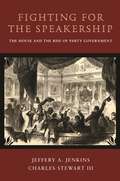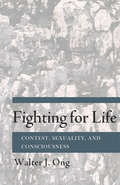- Table View
- List View
Film, Philosophy, and Reality: Ancient Greece to Godard
by Nathan AndersenFilm, Philosophy, and Reality: Ancient Greece to Godard is an original contribution to film-philosophy that shows how thinking about movies can lead us into a richer appreciation and understanding of both reality and the nature of human experience. Focused on the question of the relationship between how things seem to us and how they really are, it is at once an introduction to philosophy through film and an introduction to film through philosophy. The book is divided into three parts. The first is an introduction to philosophy and film, designed for the reader with little background in one or the other subject. The second examines the philosophical importance of the distinction between appearance and reality, and shows that reflection upon this distinction is naturally provoked by the experience of watching movies. The final part takes a close and careful look at the style and techniques of Jean-Luc Godard’s groundbreaking film Breathless in order to illustrate how such themes can be explored cinematically. The book addresses topics such as: Film: what it is and how to understand it The methods and concerns of philosophy The nature of cinematic appearances The history of metaphysics The relationship between cinema and life The philosophical relevance of film techniques. With a glossary of key thinkers, terms, and concepts, as well as sections on suggested films and further reading, this textbook will appeal to lecturers and students in undergraduate philosophy and film courses, and in courses focused on Philosophy of Film, Philosophy and Film, or Film-Philosophy.
Film in the Anthropocene: Philosophy, Ecology, and Cybernetics
by Daniel WhiteThis book provides an interdisciplinary analysis of film in the context of the Anthropocene: the new geological era in which human beings have collectively become a force of nature. Daniel White draws on perspectives in philosophy, ecology, and cybernetics (the science of communication and control in animals and machines) to explore human self-understanding through film in the new era. The classical figure of Janus, looking both to the future and the past, serves as a guide throughout the study. Both feature and documentary films are considered.
Film as Philosophy
by Bernd HerzogenrathFilm and philosophy have much in common, and books have been written on film and philosophy. But can films be, or do, philosophy? Can they “think”? Film as Philosophy is the first book to explore this fascinating question historically, thematically, and methodically.Bringing together leading scholars from universities across the globe, Film as Philosophy presents major new research that leads film studies and philosophy into a productive dialogue. It provides a uniquely sweeping, historical overview of the confluence of film and philosophy for more than a century, considering films from Jean Renoir, Lars von Trier, Jørgen Leth, David Lynch, Michael Haneke, and others; the written works of filmmakers who also theorized on the medium, including Sergei Eisenstein and Jean Epstein; and others who have written on cinema, including Hugo Münsterberg, Béla Balázs, André Bazin, Henri Bergson, Gilles Deleuze, Stanley Cavell, Alain Badiou, Jacques Rancière, and many more. Representing a major step toward establishing a media philosophy that puts the status, role, and function of film into a new perspective, Film as Philosophy removes representational techniques from the center of inquiry, replacing these with the medium’s ability to “think.” Hence it accords film with “agency,” and the dialogue between it and philosophy (and even neuroscience) is negotiated anew.Contributors: Nicole Brenez, U of Paris 3–Sorbonne; Elisabeth Bronfen, U of Zurich; Noël Carroll, CUNY; Tom Conley, Harvard U; Angela Dalle Vacche, Georgia Institute of Technology; Gregory Flaxman, U of North Carolina, Chapel Hill; Alex Ling, Western Sydney U; Adrian Martin, Monash U; John Ó Maoilearca, Kingston U, London; Robert Sinnerbrink, Macquarie U, Sydney; Murray Smith, U of Kent, Canterbury; Julia Vassilieva, Monash U, Melbourne; Christophe Wall-Romana, U of Minnesota; and Thomas E. Wartenberg, Mount Holyoke College.
Film as a Medium of Seduction: Introduction to the Seduction-Theory of Film
by Marcus StigleggerThe seduction-theory defines film in a broader sense as a medium of seduction, based on the French concept of séduction. It is a theoretical approach influenced by continental philosophy and classical film theory, linked to a three-stage analytical model. The book introduces the theoretical foundations and, using various classical and contemporary examples from film history, presents a genuine method of film analysis.
Film and the Afterlife (Routledge Studies in Religion and Film)
by David RankinThis book explores how post-death existence is represented in popular film, looking at issues such as continuity, personal identity, and the nature of existence beyond the grave. Film often returns to the theme of dying, death and the afterlife, both directly and indirectly, because there are very few subjects as compelling and universal. The book compares the representation of death, dying and the afterlife in films to scholarly surveys of attitudes towards life-after-death through the analysis of twenty films made between the end of World War II and now. It looks at the portrayals of stages between death and a final destination; spatio-temporal and personal continuity; the nature of afterlife existence in terms of embodiment, or not; and the contact between the worlds of the living and the dead. This book offers a wide-ranging view on a compelling subject in film. As such, it will be of great interest to scholars of Religion and Film, Religion and Media, the Philosophy of Religion, and the Sociology of Religion, as well as Religion, Media and Film Studies more generally .
Filaments: Theological Profiles: Selected Essays, Volume 2
by David TracyIn the second volume of his two-volume collection of essays from the 1980s to 2018, renowned Catholic theologian David Tracy gathers profiles of significant theologians, philosophers, and religious thinkers. These essays, he suggests, can be thought of in terms of Walt Whitman’s “filaments,” which are thrown out from the speaking self to others—ancient, medieval, modern, and contemporary—in order to be caught elsewhere. Filaments arranges its subjects in rough chronological order, from choices in ancient theology, such as Augustine, through the likes of William of St. Thierry in the medieval period and Martin Luther and Michelangelo in the early modern, and, finally, to modern and contemporary thinkers, including Bernard Lonergan, Paul Tillich, Simone Weil, Karl Rahner, Reinhold Niebuhr, and Iris Murdoch. Taken together, these essays can be understood as a partial initiation into a history of Christian theology defined by Tracy’s key virtues of plurality and ambiguity. Marked by surprising insights and connections, Filaments brings the work of one of North America’s most important religious thinkers once again to the forefront to be celebrated by longtime and new readers alike.
Figuring Out Figurative Art: Contemporary Philosophers on Contemporary Paintings
by Derek Matravers Damien FreemanIn 1797 Friedrich Schlegel wrote that "philosophy of art usually lacks one of two things: either the philosophy, or the art." This collection of essays contains both the philosophy and the art. It brings together an international team of leading philosophers to address diverse philosophical issues raised by recent works of art. Each essay engages with a specific artwork and explores the connection between the image and the philosophical content. Thirteen contemporary philosophers demonstrate how philosophy can aid interpretation of the work of ten contemporary artists, including: Jesse Prinz on John Currin Barry C. Smith and Edward Winters on Dexter Dalwood Lydia Goehr and Sam Rose on Tom de Freston Raymond Geuss on Adrian Ghenie and Chantal Joffe Hallvard Lillehammer on Paul Noble M. M. McCabe and Alexis Papazoglou on Ged Quinn Noël Carroll on Paula Rego Simon Blackburn and Jerrold Levinson on George Shaw Sondra Bacharach on Yue Minjun. The discussion ranges over ethical, political, psychological and religious concepts, such as irony, disgust, apathy, inequality, physiognomy and wonder, to historical experiences of war, Marx-inspired political movements and Thatcherism, and standard problems in the philosophy of art, such as expression, style, depiction and ontology of art, as well as major topics in art history, such as vanitas painting, photography, pornography, and Dadaism. Many of the contributors are distinguished in areas of philosophy other than aesthetics and are writing about art for the first time. All show how productive the engagement can be between philosophy, more generally, and art.
Figurierte Zahlen: Veranschaulichung als heuristische Strategie
by Jochen ZiegenbalgDieses Buch behandelt die Visualisierung als Methode des mathematischen Problemlösens, Begründens und Beweisens: Konkrete Beispiele zur Veranschaulichung durch mathematische Figuren und Bilder bieten einen faszinierenden Einblick in das Argumentieren anhand strukturierter und strukturierender Figuren zur Betrachtung von Zahlen und Zahlenfolgen. Die historischen Wurzeln dieses mathematischen Handwerkszeugs werden dabei so weit wie möglich einbezogen. Die Beispiele sind in der Regel konstruktiver Natur; gelegentlich wird, wo angebracht, die algorithmische Erschließung durch Hinweise auf die Programmierung mit Hilfe von Computeralgebra Systemen ergänzt. Das Buch richtet sich an Studierende und Lehrende an Schulen und Hochschulen, sowie an alle an der Elementarmathematik interessierten Nichtspezialisten, die das mathematische Arbeiten einmal außerhalb der von den Bildungsinstitutionen vorgezeichneten Pfade kennenlernen wollen. Es liefert insbesondere Lehrkräften und Lehramtsstudierenden wertvolle Anregungen, etwa zur Förderung mathematisch interessierter Schülerinnen und Schüler. In der 2. Auflage ist mit den mathematisch fundamentalen und historisch bedeutsamen Themen Wechselwegnahme, Teilbarkeit, Euklidischer Algorithmus, Inkommensurabilität und Kettenbrüche ein neues, für Visualisierungen gut geeignetes Kapitel hinzugekommen. Bereits bestehende Kapitel wurde durch Abschnitte über Trapezzahlen, ungerade Quadratzahlen und zentrierte Polygonalzahlen ergänzt.
Figures of Thought: Mathematics and Mathematical Texts
by David ReedRarely has the history or philosophy of mathematics been written about by mathematicians, and the analysis of mathematical texts themselves has been an area almost entirely unexplored. Figures of Thought looks at ways in which mathematical works can be read as texts, examines their textual strategies and demonstrates that such readings provide a rich source of philosophical issues regarding mathematics: issues which traditional approaches to the history and philosophy of mathematics have neglected. David Reed, a professional mathematician himself, offers the first sustained and critical attempt to find a consistent argument or narrative thread in mathematical texts. In doing so he develops new and fascinating interpretations of mathematicians' work throughout history, from an in-depth analysis of Euclid's Elements, to the mathematics of Descartes and right up to the work of contemporary mathematicians such as Grothendeick. He also traces the implications of this approach to the understanding of the history and development of mathematics.
Figures of Simplicity: Sensation and Thinking in Kleist and Melville (SUNY series, Intersections: Philosophy and Critical Theory)
by Birgit M. KaiserFigures of Simplicity explores a unique constellation of figures from philosophy and literature—Heinrich von Kleist, Herman Melville, G. W. Leibniz, and Alexander Baumgarten—in an attempt to recover alternative conceptions of aesthetics and dimensions of thinking lost in the disciplinary narration of aesthetics after Kant. This is done primarily by tracing a variety of "simpletons" that populate the writings of Kleist and Melville. These figures are not entirely ignorant, or stupid, but simple. Their simplicity is a way of thinking; one that author Birgit Mara Kaiser here suggests is affective thinking. Kaiser avers that Kleist and Melville are experimenting in their texts with an affective mode of thinking, and thereby continue, she argues, a key line within eighteenth-century aesthetics: the relation of rationality and sensibility. Through her analyses, she offers an outline of what thinking can look like if we take affectivity into account.
Figures of Identity: Goethe’s Novels and the Enigmatic Self (G - Reference, Information and Interdisciplinary Subjects)
by Clark S. MuenzerThe question of coherence in Goethe's novels, which, like Faust, compelled his attention throughout his creative life, has only recently occupied a few critics. Professor Muenzer's study offers the most comprehensive effort of this kind by examining the problematic nature of self-definition through the four novels and its emergence as a discursive process of the imagination.The self of these texts, Muenzer suggests, evolves as a symbolic construct that records a patter of pursuit for each of their protagonists and orients the reader toward three basic goals of human aspiration. Thus, Werther aspires to purposefulness as a center of teleological fulfillment, while the hero of Wilhelm Meister's Apprenticeship refers to an ideological center of participation in his social desire. Eduard, in The Elective Affinities, presumes to occupy a center of archaeological power through his typically self-assertive strategies.In the last of his novels, Wilhelm Meister's Journeymanship, Goethe articulates the need to balance all such self-involved behavior with an attitude of self-denial. Apparently, the mind can orient itself through centers of purpose, order, and power, but it must also recognize the illusion of their attainment. Identity does not involve a substantive presence, and the result of self-definition for Goethe is interpretive work.Each of Professor Muenzer's interpretations has been guided by this premise. The interests of all of Goethe's novelistic protagonists, he concludes, "serve as orienting postures toward goals that cannot be literally achieved." Consequently, symbolic resolutions are proposed. These then introduce new problems as points of departure in subsequent works. The hidden agenda of Goethe's work as a novelist is a self that exists as a textual problem, a series of interpretive moves that endlessly defer the attainment of self presence by supplementing each other in narrative fictions.
Figures of Catastrophe
by Francis MulhernA bold new vision of the modern English novelThe leading critic Francis Mulhern uncovers a hidden history in the fiction of the past century, identifying a central new genre: the condition of culture novel. Reading across and against the grain of received patterns of literary association, tracing a line from Hardy and Forster, through Woolf, Waugh and Bowen, to Barstow, Fowles, Rendell, Naipaul, Amis, Kureishi and Smith, he elucidates the recurring topics and narrative logics of the genre, showing how culture emerges as a special ground of social conflict, above all between classes. The narrative evaluations of culture's ends--the aspirations and the destinies of those whose lives are the subject of these novels--grow steadily darker over time, and the writing itself grows more introverted.A concluding discussion elicits the characteristics of the English condition of culture novel, in an international setting, and closes in, finally, on the central conundrum of the genre: its uncanny reprise, in its own plane, of the historical arc of the modern labour movement in Britain, from its beginnings in the late nineteenth century through its post-war heyday to the seemingly inexorable decline of recent decades.From the Hardcover edition.
The Figure of the Witness in International Criminal Tribunals: Memory, Atrocities and Transitional Justice
by Benjamin ThorneThis book analyses how international criminal institutions, and their actors – legal counsels, judges, investigators, registrars – construct witness identity and memory. Filling an important gap within transitional justice scholarship, this conceptually led and empirically grounded interdisciplinary study takes the International Criminal Tribunal for Rwanda (ICTR) as a case study. It asks: How do legal witnesses of human rights violations contribute to memory production in transitional post-conflict societies? Witnessing at tribunals entails individuals externalising memories of violations. This is commonly construed within the transitional justice legal scholarship as an opportunity for individuals to ensure their memories are entered into an historical record. Yet this predominant understanding of witness testimony fails to comprehend the nature of memory. Memory construction entails fragments of individual and collective memories within a contestable and contingent framing of the past. Accordingly, the book challenges the claim that international criminal courts and tribunals are able to produce a collective memory of atrocities; as it maintains that witnessing must be understood as a contingent and multi-layered discursive process. Contributing to the specific analysis of witnessing and memory, but also to the broader field of transitional justice, this book will appeal to scholars and practitioners in these areas, as well as others in legal theory, global criminology, memory studies, international relations, and international human rights.
The Figure of the Migrant
by Thomas NailThis book offers a much-needed new political theory of an old phenomenon. The last decade alone has marked the highest number of migrations in recorded history. Constrained by environmental, economic, and political instability, scores of people are on the move. But other sorts of changes--from global tourism to undocumented labor--have led to the fact that to some extent, we are all becoming migrants. The migrant has become the political figure of our time. Rather than viewing migration as the exception to the rule of political fixity and citizenship, Thomas Nail reinterprets the history of political power from the perspective of the movement that defines the migrant in the first place. Applying his "kinopolitics" to several major historical conditions (territorial, political, juridical, and economic) and figures of migration (the nomad, the barbarian, the vagabond, and the proletariat), he provides fresh tools for the analysis of contemporary migration.
The Figure of Nature: On Greek Origins (Studies in Continental Thought)
by John SallisBroaching an understanding of nature in Platonic thought, John Sallis goes beyond modern conceptions and provides a strategy to have recourse to the profound sense of nature operative in ancient Greek philosophy. In a rigorous and textually based account, Sallis traces the complex development of the Greek concept of nature. Beginning with the mythical vision embodied in the figure of the goddess Artemis, he reanimates the sense of nature that informs the fragmentary discourses of Anaximenes, Heraclitus, Parmenides, and Empedocles and shows how Plato takes up pre-Socratic conceptions critically while also being transformed. Through Sallis's close reading of the Theaetetus and the Phaedo, he recovers the profound and comprehensive concept of nature in Plato's thought.
Figurations of Human Subjectivity: A Contribution to Second-Order Psychology
by Gabriel BianchiThis book takes an empirically grounded perspective on research in values, intimacy and sexuality, among other topics in psychology, to highlight the importance of searching for human subjectivity in its diversity, plurality and self-generativity. The author conducts an in-depth discussion on the methodological and epistemological issues enabling the study of subjectivity, and argues that in order to improve the contribution of psychology to human knowledge, a study of subjectivity must be at the forefront.This book presents a critical reflection of the author’s decades-long research within psychology to argue for a significant paradigm shift in the conception and execution of psychological research: a shift to “second order psychology”.
Figurationen spätmoderner Lebensführung (Adoleszenzforschung #10)
by Katarina Busch Susanne Benzel Benedikt Salfeld Julia SchreiberDer Band versammelt Beiträge, die sich dem Konnex von Psyche und Gesellschaft widmen, wie er auch im Zentrum der Arbeiten von Benigna Gerisch und Vera King steht. Anhand unterschiedlicher Themen wie Adoleszenz, Migration, Alter, Geschlecht und Generationenverhältnisse werden verschiedene Dimensionen spätmoderner Lebensführung beleuchtet. Übergreifend wird so der Frage nachgegangen, wie das Ineinandergreifen von psychischen und sozialen Dynamiken untersucht und verstanden werden kann.
Figural Realism: Studies in the Mimesis Effect
by Hayden WhiteOriginally published in 1998. In his earlier books such as Tropics of Discourse and The Content of the Form, Hayden White focused on the conventions of historical writing and on the ordering of historical consciousness. In Figural Realism, White collects eight interrelated essays primarily concerned with the treatment of history in recent literary critical discourse. "'History' is not only an object we can study," writes White, "it is also and even primarily a certain kind of relationship to 'the past' mediated by a distinctive kind of written discourse. It is because historical discourse is actualized in its culturally significant form as a specific kind of writing that we may consider the relevance of literary theory to both the theory and the practice of historiography."
Fighting Words: Black Women And The Search For Justice (Contradictions Of Modernity Series #Volume Seven)
by Patricia Hill CollinsA professor of sociology explores how black feminist thought confronts the injustices of poverty and white supremacy, and argues that those operating outside the mainstream emphasize sociological themes based on assumptions different than those commonly accepted.
Fighting Words: Individuals, Communities, and Liberties of Speech
by Kent GreenawaltShould "hate speech" be made a criminal offense, or does the First Amendment oblige Americans to permit the use of epithets directed against a person's race, religion, ethnic origin, gender, or sexual preference? Does a campus speech code enhance or degrade democratic values? When the American flag is burned in protest, what rights of free speech are involved? In a lucid and balanced analysis of contemporary court cases dealing with these problems, as well as those of obscenity and workplace harassment, acclaimed First Amendment scholar Kent Greenawalt now addresses a broad general audience of readers interested in the most current free speech issues.
Fighting Songs and Warring Words: Popular Lyrics of Two World Wars
by Brian MurdochFirst published in 1990. Routledge is an imprint of Taylor & Francis, an informa company.
Fighting Scholars: Habitus and Ethnographies of Martial Arts and Combat Sports (Key Issues In Modern Sociology Ser.)
by Raul Sanchez Garcia Dale C. SpencerFighting Scholars brings to the fore the ethnographic study of combat sports and martial arts as a means of exploring embodied human existence. The book's main claim is that such activities represent privileged grounds to access different social dimensions, such as emotion, violence, pain, gender, ethnicity and religion. To explore these dimensions, the concept of 'habitus' is presented prominently as an epistemic remedy for the academic distant gaze of the effaced academic body. The different contributions of this volume are aligned within the same project that began to crystallize in Loïc Wacquant's 'Body and Soul': the construction of a 'carnal sociology' that constitutes an exploration of the social world 'from' the body. The book is divided into three sections. In the first section, the editors introduce the field, providing a typology of existing literature. The second section contains the contributions of the authors, discussing their respective approaches to embodied ethnography, their use of the concept of 'habitus', and ethnographic findings. The third section contains a conclusion by the editors - reflecting on existing conceptions of 'habitus' and interdisciplinary possibilities for rethinking the concept - and an epilogue by Loïc Wacquant critically assessing the whole volume.
Fighting Political Gridlock: How States Shape Our Nation and Our Lives
by David J. ToscanoIn this profoundly polarized era, the nation has been transfixed on the politics of Washington and its seemingly impenetrable gridlock. Many of the decisions that truly affect people’s lives, however, are being made not on the federal level but in the states. Faced with Washington’s political standoff, state governments are taking action on numerous vital issues, often impacting citizens and their communities far more than the decision makers in D.C. Despite this, few Americans really understand their state governments or the issues they address. In Fighting Political Gridlock, David Toscano reveals how the states are working around the impasse in Washington and how their work is increasingly shaping society.Long a central figure in one of the most important legislative bodies in the nation, the Virginia House of Delegates, Toscano brings a unique expertise to this urgent and timely discussion. Beginning with an analysis of state responses to COVID-19, including the processes and consequences of declaring states of emergency, he goes on to detail how various states are attacking issues in different ways–from education and voting to criminal justice and climate change–and provides a broad overview of how state actions affect our system of federalism. Toscano concludes with a call to action and civic engagement, including suggestions for how citizens and public officials can revitalize American democracy.
Fighting for the Speakership: The House and the Rise of Party Government (Princeton Studies in American Politics: Historical, International, and Comparative Perspectives #131)
by Jeffery A. Jenkins Charles StewartThe Speaker of the House of Representatives is the most powerful partisan figure in the contemporary U.S. Congress. How this came to be, and how the majority party in the House has made control of the speakership a routine matter, is far from straightforward. Fighting for the Speakership provides a comprehensive history of how Speakers have been elected in the U.S. House since 1789, arguing that the organizational politics of these elections were critical to the construction of mass political parties in America and laid the groundwork for the role they play in setting the agenda of Congress today. Jeffery Jenkins and Charles Stewart show how the speakership began as a relatively weak office, and how votes for Speaker prior to the Civil War often favored regional interests over party loyalty. While struggle, contention, and deadlock over House organization were common in the antebellum era, such instability vanished with the outbreak of war, as the majority party became an "organizational cartel" capable of controlling with certainty the selection of the Speaker and other key House officers. This organizational cartel has survived Gilded Age partisan strife, Progressive Era challenge, and conservative coalition politics to guide speakership elections through the present day. Fighting for the Speakership reveals how struggles over House organization prior to the Civil War were among the most consequential turning points in American political history.
Fighting for Life: Contest, Sexuality, and Consciousness
by Walter J. OngWhat accounts for the continued popularity of the macho image, the fanaticism of sports enthusiasts, the perennial appeal of Don Quixote's ineffectual struggles? Walter J. Ong addresses these and related questions as he offers new insights into the complex ways in which human life is affected by contest. Ong argues that the struggle for dominance, which he feels is crucial among higher animal species, is more immediately critical for males than for females, helping males to manage persistent insecurity and to establish sexual identity. The male agonistic drive finds an outlet in contests as diverse as football, cockfighting, and chess--the last, the ultimate intellectualization of formalized territorial combat. Demonstrating the importance of contest in biological evolution and in the growth of consciousness out of the unconscious, Ong shows how adversarial today's shifting patterns of contest in such arenas as spectator sports, politics, business, religion, academe, and the history of rhetoric. Human internalization of agonistic drives, he concludes, can foster the deeper discovery of the self and of distinctively human freedom.
